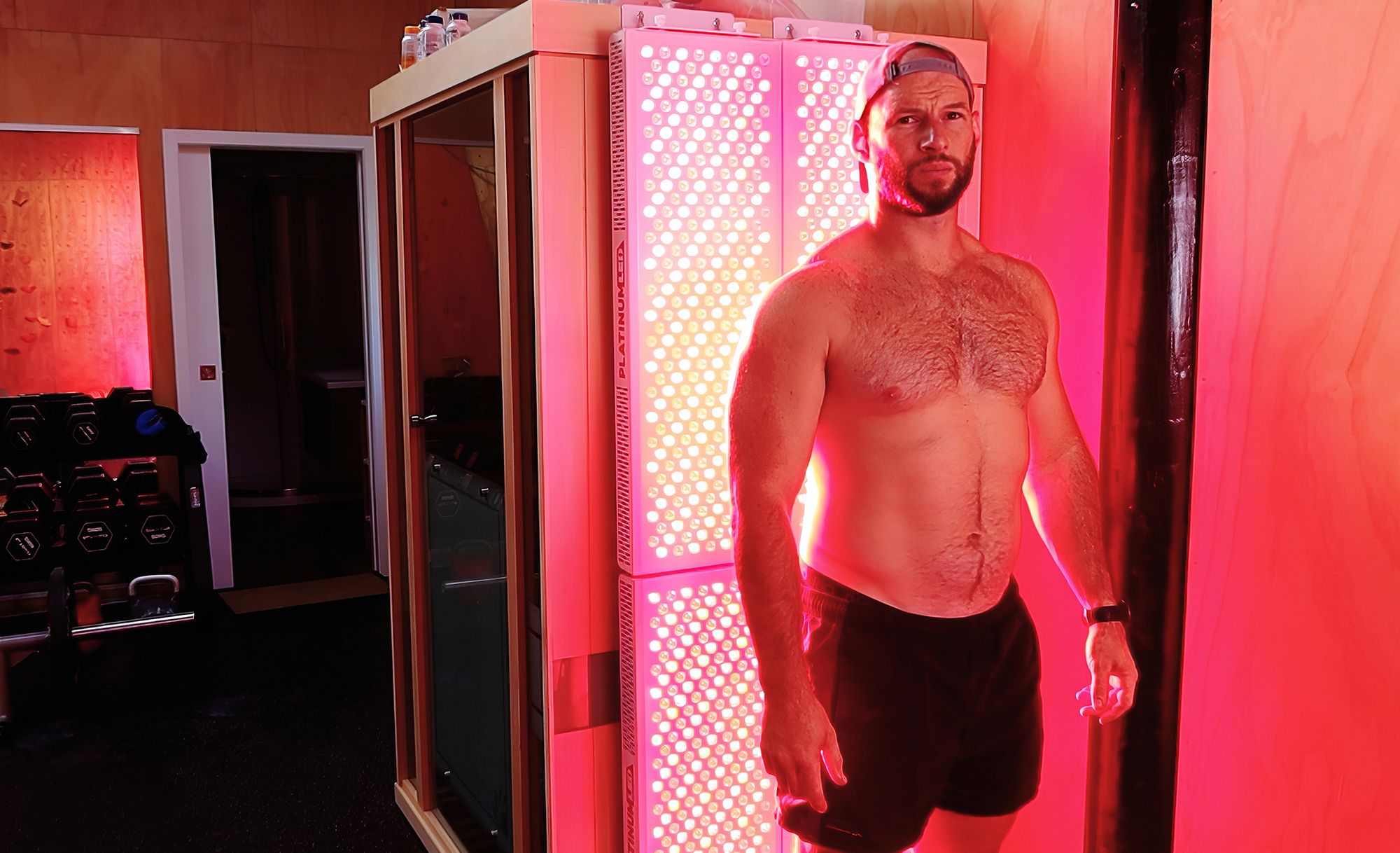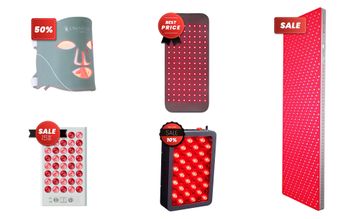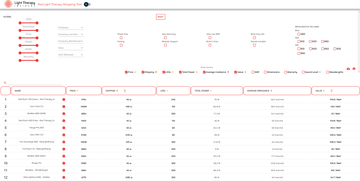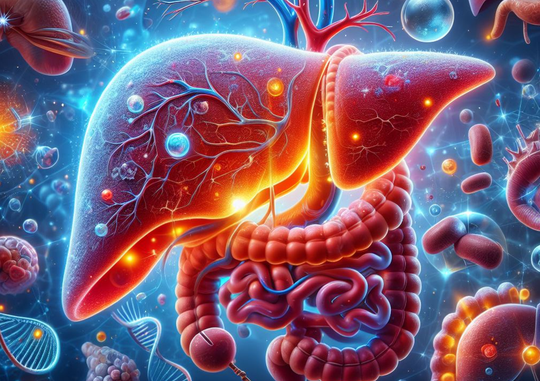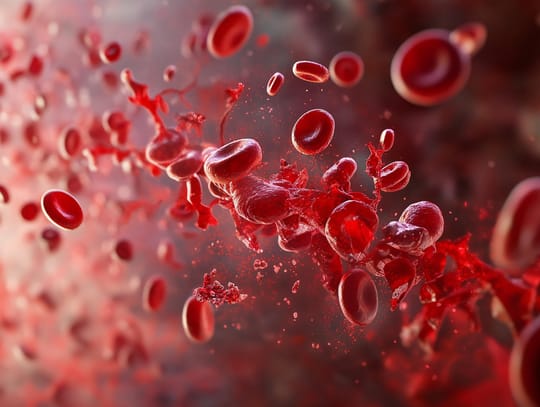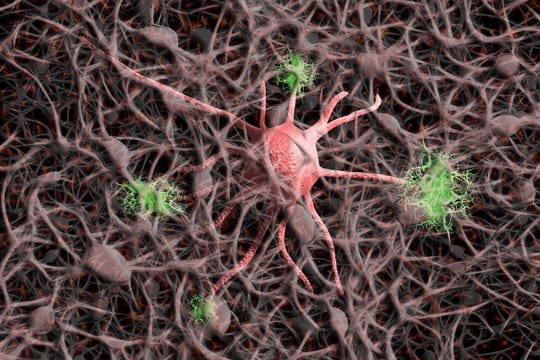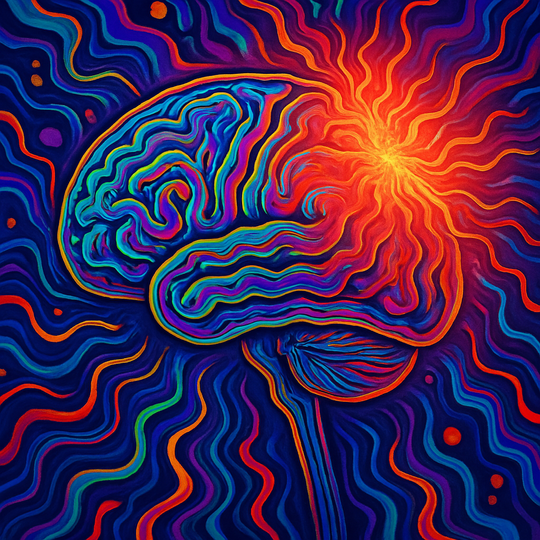In this blog post, we'll cover the basics of what is red light therapy. We'll go through all the basics, such as the red light therapy history, whether it works, the benefits, potential side effects, how to use it, the best resources, where to buy it, and so forth.
Let's begin with exploring the word "light therapy" of red light therapy:
What Is Light Therapy?
First up, let's consider what light therapy is. Light therapy is as old as humanity. As long as humans have been around, your ancestors have lived at least part of the day in sunlight. That sunlight is the original form of light therapy.
Light therapy means using light to improve health, performance, or other outcomes influenced by your biology. Almost everyone knows that by spending time in the sun, without clothing, you're creating vitamin D in the skin (1; 2; 3; 4; 5).
But sunlight exposure has tons of other health benefits as well that most people aren't aware about. And, you can't get all the benefits of vitamin D from a pill. A recent review study on sunlight exposure explains the following:
"Studies in the past decade indicate that insufficient sun exposure may be responsible for 340,000 deaths in the United States and 480,000 deaths in Europe per year, and an increased incidence of breast cancer, colorectal cancer, hypertension, cardiovascular disease, metabolic syndrome, multiple sclerosis, Alzheimer's disease, autism, asthma, type 1 diabetes and myopia. Vitamin D has long been considered the principal mediator of beneficial effects of sun exposure. However, oral vitamin D supplementation has not been convincingly shown to prevent the above conditions; thus, serum 25(OH)D as an indicator of vitamin D status may be a proxy for and not a mediator of beneficial effects of sun exposure. New candidate mechanisms include the release of nitric oxide from the skin and direct effects of ultraviolet radiation (UVR) on peripheral blood cells." (3)
That's an astounding statement.
Let us break that statement down into more detail.
- First, of all, your overall cancer risk actually goes down with sufficient sunlight exposure, even though the risk of some types of skin cancers might go up.
- Secondly, sunlight exposure has a huge effect on your overall disease risk, such as diabetes, Alzheimer's, neurological conditions, and others.
- Thirdly, you can't take a supplement to get these benefits. You need to expose your skin to sunlight to get most of the benefits. Taking a vitamin D pill only gives your body a slight fraction of the benefits.
Now, light therapy is as old as humanity. Many different cultures, such as the Egyptians and Aztecs, have even celebrated the sun as life-giving source. Of course, these cultures didn't have the exploratory method of modern science to explain why exactly sunlight has the benefits it does.
Infrared light - which is what makes the sun feel hot on your skin - was only discovered in the 19th century. And, the effects of ultraviolet light creating vitamin D in the skin was only discovered in the early 20th century (4; 5). Modern infrared saunas were only invented in the 1960s in Japan (6). And, during that same time, what we call red light therapy today was also invented.
But let's take a step back:
The most crucial point of this section is that you use light therapy to intentionally make your biology work better, providing benefits such as better health, more outstanding performance, anti-aging benefits, and so forth. Red light therapy is one form of light therapy that is quickly becoming one of the most important.
So let's explore what red light therapy is:
What Is Red Light Therapy?
Red light therapy uses light sources such as LEDs and lasers to emit either red or infrared light or a combination of these for health improvement. Generally, that treatment is minimally heating. So you're not going to sweat profusely from red light therapy as you will from an infrared sauna, even though your tissues might warm up slightly.
The red and infrared light doesn't just hit your skin though. Instead, the light penetrates into your body (7; 8; 9; 10; 11; 12; 13). For different tissues there's a different penetration depth, though. Bone and fat are tissues that are hard to penetrate, for instance. And, skin thickness can influence how far the light ventures into your body.
Having said that, different types of red and infrared light penetrate at least a few centimeters into your body. And once int he body, that light has a biological effect.
If you're interested in learning more about the systemic effects of red light therapy, check the following video by Alex Fergus:
In this video, Alex Fergus gives many different examples from scientific studies from people who treated very small bodily areas and received biological benefits
But, ideally, you'll want to hit most of your body's tissues to get the most benefits out of your red light therapy treatments. Those treatments are carried out through many different means, such as red light therapy panels, mats, belts, beds, and more.
Let's explore these different options:
Different Red Light Therapy Methods Explained: Panels, Mats, Belts, Masks, Beds, And More
Many different tools to apply red light therapy exist. These tools include red light therapy beds, panels, belts, masks, mats, spot lasers, and more. All of these methods to apply red light therapy have one thing in common though: in 99% of cases, they use LEDs or lasers to emit the light.
That light then hits your skin and enters your body, having a biological effect. We'll talk about the benefits of that light soon.
Size is the most obvious difference here. For instance, you can see the NovoTHOR red light therapy bed below:
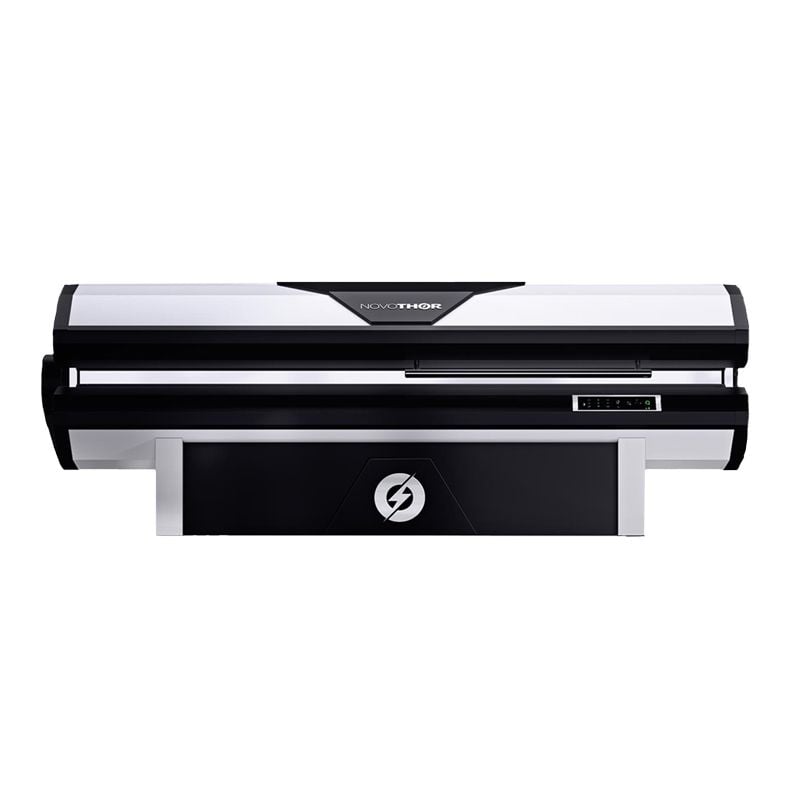
But, that NovoTHOR is unaffordable for the average person. The NovoTHOR is also mostly made for commercial use, such as clinics for instance. For that reason, most residential consumers don't opt for a red light therapy bed but for panels instead.
Red light therapy panels, arguably are the most versatile. In a red light therapy panel, you've got many different "Light Emitting Diodes" or LEDs. These LEDs emit light at distinct frequencies. Those frequencies are measured in nanometers (nm). Light emitted at 630nm or 660nm is red light, for instance. Light emitted at 810nm or 850nm or 940nm is infrared light.
So let's check the number of LEDs in different products, broadly speaking:
- Handheld red light therapy products may have up to 20 LEDs
- Tabletop panels may have up to 100 LEDs
- Wall panels have up to 300 LEDs
- Body panels have more 301 LEDs or more
- Red light therapy beds may have thousands of LEDs
There's no or wrong here. Also, you may think: "But what about red light therapy masks and belts and mats?"
Red light therapy masks and belts and mats and belts technically have many LEDs, such as dozens or hundreds, but most frequently these LEDs don't emit tons of light because of these products rarely have cooling elements.
If you're curious about different types of red light therapy products, then check out the following videos by Alex Fergus:
- The best handheld red light therapy products - which are ideal for travel as they fit in a carryon bag!
- The best beauty tabletop panels, the best budget tabletop panels, and the best premium tabletop panels.
- The best wall panels, which can treat larger parts of your body but not the entire body. Wall panels deliver the most bang for your buck for most consumers.
- Red light therapy panels versus beds - why a panel is the best option financially by far for most consumers.
- Red light therapy masks versus panels - some people will do very well with a mask because they're only interested in beauty of the face. But if you have different goals, you'd probably want to opt for a panel.
Hopefully, you get the point. There are many different methods of applying red light therapy on the market, which range from small to very big.
Bigger red light therapy products, in turn, have the benefit of giving you better light coverage. In general, the more spread out the LEDs are, the bigger the area of your body that is treated.
So, a small handheld red light therapy product that has 12 LEDs at the size of your hand is extremely inefficient to treat your entire body. The handheld product is mostly good for treatment of smaller bodily areas instead, such as a sore knee or a shoulder tendon that's impinging or inflamed.
If you want to learn more about this topic, check out the video below on red light therapy light coverage:
In this video, Alex Fergus shows that if LEDs are not directly aimed at a bodily tissue, it won't receive much light either. However, if you've got a bigger setup, you'll still get a very even spread across the body at a 12-inch distance or even a 24-inch distance
The bottom line is this: for maximum health benefits, you have to directly treat an area with light. However, even with spot treatments, other untreated areas of the body still receive some benefits.
Next up, let's consider how red light therapy emerged historically:
History Of Red Light Therapy
Understanding a historical background allows us to better understand the present. Right now, for instance, there are 8,000+ studies on red light therapy - almost 90% of these studies have very positive outcomes. And yet, most people haven't even heard about red light therapy.
Well, the reason you haven't heard about red light therapy is because it's only become economically viable recently (14). For decades, lasers were the main method of applying "red light therapy". And lasers aren't always safe to operate if a medical professional isn't using them - hence, laser never entered the residential customer market.
Only in the 2000s did the price of LEDs come down so much that red light therapy masks, panels, belts, and beds with LEDs became affordable. That trend continues, and a great red light therapy at home setup is cheaper than ever!
And, over the course of decades, the amount of research on red light therapy has also been exploding. Ever year, the number of studies on this topic continues increasing. And thus, we're finding out more and more about different red light therapy health benefits.
Red light therapy isn't named that way in the medical industry though. Right now, medical researchers have settled on the term "photobiomodulation", which means "light modulating life" or "light modulating biology" when translated.
Red light therapy has been known by many other terms, such as "Low-Level Laser Therapy" and "Low-Level Light Therapy", all definitions that come with their own limitations.
But let's check the history of photobiomodulation, sourced from one of the primary experts in photobiomodulation today, James Carroll (15). We're paraphrasing some of the most important photobiomodulationd dates here -
1967: the healing effects of lasers are discovered, for wound healing alone
1983: physical therapists begin treating sports injuries with lasers
1998: NASA uses lasers for healing in space
2008: World Health Organization starts recommending photobiomodulation for neck pain
2009-today: many imporant health organizations and journals begin recommending photobiomodulation for many different goals, such as for muskuloskeletal pain, cancer side effects such as oral mucositis, non-specific lower back pain, osteoarthritis and rheumatoid arthritis, and many other medical goals
2020: 8,000+ academic papers are now published on photobiomodulation
So, in the course of a little over 50 years, we went from photobiomodulation benefits for wound healing alone, to photobiomodulation benefits for nearly everything.
You may think "How is that possible? How can one therapy influence so many health outcomes?" We'll expolore the answer to that question in the next section.
How Does Red Light Therapy Work? Biological Mechanisms Explained
There's heaps of discussions about how photobiomodulation - more commonly known as red light therapy - has so many effects on so many health outcomes (16; 17; 18; 19; 20; 21).
A recent scientific review on the mechanisms of red light therapy states that, in very complicated language, which we'll break down into simpler statements in a second:
"One of the most important chromophores is cytochrome c oxidase (unit IV in the mitochondrial respiratory chain), which contains both heme and copper centers and absorbs light into the near-infra-red region. The leading hypothesis is that the photons dissociate inhibitory nitric oxide from the enzyme, leading to an increase in electron transport, mitochondrial membrane potential and ATP production. Another hypothesis concerns light-sensitive ion channels that can be activated allowing calcium to enter the cell. After the initial photon absorption events, numerous signaling pathways are activated via reactive oxygen species, cyclic AMP, NO and Ca2+, leading to activation of transcription factors. These transcription factors can lead to increased expression of genes related to protein synthesis, cell migration and proliferation, anti-inflammatory signaling, anti-apoptotic proteins, antioxidant enzymes. Stem cells and progenitor cells appear to be particularly susceptible to LLLT." (16)
So what do these statements mean?
First off, the consensus right now is that red light therapy affects so-called "mitochondria" in your cells. Mitochondria can be envisioned as energy-producing factories of your cells. If you've got more, bigger, and more efficient mitochondria, your cells increase energy production.
Just like a car with a bigger and more efficient engine is faster and performs better, the same is true for mitochondria. The red and near infrared light affects a specific energy-creation step in the mitochondria called "cytochrome C oxidase".
The end result here is an increase in ATP or "Adenosine Tri-Phosphate" production. ATP is like gasoline for your car - without gasoline (or electricity today) your car won't work.
Another mechanism is that red and near-infrared light, either directly or indirectly, leads to the release of nitric oxide. In the cell, nitric oxide is a limitation for energy production. The same is true for nitric oxide in relation to blood flow - hence, circulatory benefits of red light therapy exist.
Then, other mechanisms exist such as the decrease in systemic inflammation and reactive oxygen species (ROS). ROS are a byproduct of energy production and contribute to the aging process as well.
But let's return to the red light therapy guru we just quoted, James Carroll. Carroll states that there's one primary mechanism by which red light therapy works - we're paraphrasing here:
In medicine, you'll have to be skeptical towards any therapy that can claim to do everything for everyone. So, what explains the universal benefits that red light therapy (or scientfically "photobiomodulation") has for so many benefits?
The explanation here is that inflammation and oxidative stress go down, which in turn improves energy-creation.
And, it's not hard to imagine that with more energy, all processes in a biological system work better.
Simply put, you shine red and near-infrared light at a tissue, at the right wavelength, intensity and duration, and the tissue either heals or becomes more resilient.
The light doesn't potentially damage DNA as with ultraviolet light. And, in red light therapy, the light is non-heating unlike infrared saunas. And, as there's no ultraviolet light, you don't get vitamin D benefits from the therapy, even though it does support health.
How exactly?
Next up, let's explore the red light therapy benefits in more detail:
Benefits Of Red Light Therapy
With 8,000+ studies published on red light therapy, it's very hard to describe the benefits of red light therapy in a few sentences or paragraphs. The red light therapy benefits are almost uncountable, and hence, we'll limit ourselves to the most important benefits here.
Red light therapy has benefits such as (22; 23; 24; 25, 26; 27; 28; 29):
- Lowering local and systemic inflammation, which has a cascading effects for many health conditions and their risk, such as diabetes, heart disease, metabolic disorders, and more.
- Enhancing energy production in the body.
- Boosting sleep quality.
- Quicker healing of muscle and other types of injuries. Faster recovery during sports as well as enhanced performance.
- Impeding chronic pain, which is a huge issue as more people are affected by it than heart disease, diabetes and cancer combined.
- Improving oral health while lowering pain during many orthodontic and dental procedures.
- Countering side effects from cancer and cancer treatments, such as nerve pain and oral mucositis.
- Lowering the risk for brain diseases, such as dementia and Alzheimer's. Cognitive performance may also improve, depending on circumstances.
- Countering anxiety and depression.
- Enhancing skin health and wound healing.
Don't believe it?
Well, thousands of studies aren't wrong as they're usually placebo controlled. Also, if you'd like to learn more about the lived experience of people using red light therapy, check the video below:
In this video, Alex Fergus goes through many testimonials on what people who bought red light therapy products have personally experienced after they started using it. The testimonials are astounding!
And, if you'd like to hear what benefits Alex has experienced, then check out this video:
This video explains what happens when Alex Fergus stopped using red light therapy for four weeks. He didn't turn into an old man but he did lose out on some very impressive benefits that he loved over the years!
And, lastly, if you'd like a video where Alex zooms in on some of the red light therapy benefits, check out the video below:
In this video, Alex takes a deeper dive into some of the red light therapy benefis, such as skin and beauty benefits, wound healing, and benefits for the brain
Next up, let's consider some potential red light therapy side effects:
Potential Red Light Therapy Side Effects
Yes, red light therapy has potential side effects. But, anything in life has potential side effects! If you drink too much alcohol, you'll get side effects. The same is true, however, for even coffee and water! Sure, drinking two liters water per day is great but two gallons will set your health back.
And, in terms of light therapy, getting some sunlight exposure is great, but ten hours in a day is overkill. The same is true for red light therapy - if you do too much, the benefits start to level off and even become negative eventually. In other words, if you overdo it, you'll perform and feel worse than before.
So there's a thing called "dosing". That topic is quite scientifically complicated, so we won't go into detail here. The easiest way to avoid problems is to follow the instructions of the company offering the red light therapy product.
Most companies have thought hard and long about the best way to use their products, so you can rest assued that you'll avoid the greatest risks of underusing or overusing a product that way.
However, there are a few potential side effects when using red light therapy:}
- If you've got cancer or suspect cancer, clear red light therapy usage with your physician first. Red light therapy improves blood flow and may cause spread of the cancer throughout the body, which is why we don't recommend using red light therapy in this case. In some cases, you can cover up the cancerous area with your clothes, although you'll need a doctor's green light for that first.
- If you're in poor health, red light therapy treatments can feel tiring. You'll need to lower the dose at first. Red light therapy is what is called a "hormetic stressor" - like exercise or cold showers - which means it temporarily increases stress on the body. If you've got chronic fatigue or fibromyalgia, you cannot use red light therapy for the normal duration, just like you cannot exercise like a person without these conditions.
- For eye health, don't look directly into the light with your eyes opened. This is common sense but bears repeating. In the same way you don't get into the sunlight while directly looking at the sun when that sun is high up the sky, you also don't use a powerful red light therapy panel while directly looking at it.
- With pregnancy, don't treat your belly directly.
- If you've got a pulsing red light therapy panel, and epilespy or are susceptible to epilepsy, be very careful as the flickering effect can create an episode. So, low pulsing frequencies such as 10 Hz - whereby the light turns on and off 10 time per second - are very dangerous if you've got any epileptic susceptibility.
- Some people make the argument that it's unknown what the long-term effects of red light therapy will be. An example here of a proposed side effect would be the overstimulation of the mitochondria. However, given that we've now got years and decades of good results with red light therapy, this side effect is far less likely. People who have been using red light therapy for decades get cumulative positive effects, not side effects. If there were strong side effects over time these problems would have emerged more quickly.
And, now that you're ready for your first session, let's talk about the basics of using red light therapy:
How To Use Red Light Therapy Basics
Generally, we recommend following the instructions of the company offering the red light therapy. These companies have often thought about dose and therefore make recommendations that are good for the greatest number of people.
A company offering a red light therapy face mask, for instance, may instruct you to use the product thrice weekly for 20 minutes per day. Or, a red light therapy company selling a wall panel may recommend using the panel for 5 minutes per day on each area that you're targeting at a 12-inch distance, five times per week.
If that sounds too complicated, then just follow the instructions of the product you're buying. If you want to take a deeper dive into red light therapy dosing, however - which will lead to much more understanding - then read the text below:
There are three main parameters that determine red light therapy dosing. I'll explore these below:
First, there's the wavelength, such as red light at 630nm or 660nm, or near-infrared light at 810nm or 1,070nm.
Secondly, there's the area that's treated. For the most extensive health benefits, you'll ideally want each area of your body treated.
Thirdly, there's the dose. The power coming out of a red light therapy product is usually measured in mW/cm2. By multiplying that mW/cm2 by 60 seconds you'll arrive at a dose in Joules / cm2.
For superficial treatments, a dose of around 5 Joules (J) is optimal. The skin is an example of a superficial tissue. For deeper tissues, you'll want a maximum dose of around 60 or 70 J/cm2.
So let's consider a dosing example. Let's say I've got a tabletop panel that emits 50 mW/cm2 of light. In that case, I'll end up with 50 mW/cm2 * 60 = 3,000 mW/cm2 in total = 3 Joules of energy per cm2.
I'd need to treat the tissue for 1.5 minutes if I'd want an optimal dose for superficial tissues. For deeper tissues, I may need 10 minutes of treatment though (30 J/cm2), or even 20 minutes of total treatment time (60 J/cm2).
And, this example is still an oversimplification as there are other factors making such calculations more difficult.
Red light therapy dosing is a very complicated topic. Only general guidelines exist here, and there are many unknowns - there is no universally hard science that tells you exactly what the best dosing protocol is in each circumstance. We know perfectionists, detailed oriented people, and neurotic people won't be happy with this answer, but it's the best we can do.
Soon, we'll publish a guide on red light therapy dosing that gives the best general guidelines based on current evidence, and many caveats that exist with dosing as well.
For now, don't overcomplicate things and just follow instructions. Or, alternatively, experiment with higher or lower dosing protocols.
Who Is Red Light Therapy For?
Next up, you may ask: "Who is red light therapy for?" Should you only use red light therapy if you've got a chronic health condition? Or, alternatively, should most athletes use red light therapy?
Well, the simple answer here is that red light therapy is for almost everyone. You see, many people, now that we're no longer living in an agricultural society, don't get much light exposure anymore. Houses and offices are frequently very poorly illuminated in the sense that the amount of light (measured in lux) is extremely low compared to what you're getting outdoors.
Outdoor lux levels are higher than 100,000 lux on a bright sunny day. And, you're lucky if your house has a lux intensity of 600 or 800 lux. So after the Industrial Revolution, people slowly moved indoors and were then no longer exposed to sufficient light during the day.
Some theories assume that red light therapy has such tremendous benefits because people lack sunlight exposure in their daily lives, which we don't necessarily agree with. We think red light therapy has benefits above and beyond sunlight exposure's effects.
Having said that, red light therapy will compensate big time for people who don't spend enough time in the sun. And, for that reason, it's a total game-changer.
And not only will red light therapy help people with many chronic health conditions big time - although there's not evidence for all health conditions. Red light therapy also helps improve your health in general. So, already healthy people tend to get more resilient when they're using red light therapy. And, the therapy has many benefits for domains such as athletic recovery, sleep quality, cognitive performance, and more.
Hence, almost anyone will benefit from red light therapy. Exercise and a healthy diet are good comparisons here - almost regardless of circumstances will these interventions benefit you big time in some way or another.
Next up, let's consider a few red light therapy resources that we highly recommend:
Red Light Therapy Resources
Well, there are tons of red light therapy resources out there. First off, of course, we highly recommend our own Lighttherapyinsiders.com website where you can find reviews, guides, databases with products, cheatsheets, the latest news, and anything imaginable about red light therapy specifically and light therapy in general.
Secondly, there's the Alex Fergus YouTube channel where we post three new videos per week on red light therapy. Subscribe to that channel if you're interested in learning a lot more.
Thirdly, if you like researching yourself, we cannot recommend the Excel sheet with 8,000+ studies by Vladimir Heiskanen strongly enough. That database is searchable for tissues and health conditions and summarizes the most important outcomes for each of these thousands of studies. In that database, you can use the CTRL+F function to search for specific tissues, pathologies, or goals.
For instance, you can search for red light therapy studies on Alzheimer's Disease, or opioid addiction, or neck pain, or muscle recovery.
Where To Get Red Light Therapy
So, you're convinced that red light therapy is the best thing since sliced bread? In that case, we don't recommend buying a product immediately. Instead, we recommend reading up first and checking your options.
For instance, you can find tons of different reviews on this website or on the red light therapy reviews YouTube channel by Alex Fergus. Often, there's a huge price difference between many products. And, shipping and import taxes can also vary widely depending on where you're buying from.
So, if you're based in the EU, it's generally smarter to buy from a company that has a warehouse there. That way, you'll avoid income taxes. At the very least, it's smart to buy from a company that offers free worldwide shipping.
But, the price, shipping, and potential import duties is just one out of potentially dozens of factors that influence what product you should buy. So, for that reason, we highly recommend checking out Alex Fergus' red light therapy buyer's guide video below, that explains what to look out for in great detail:
In this red light therapy buyer's guide, Alex Fergus explains 15+ criteria of what to look out for when buying a product. Some of these choices have long-term implications, and hence, for that reason it's smart to do some research first before making a purchase
Building a red light therapy setup that covers your entire body can cost thousands of dollars. So, you'll want to spend that money just once and not multiple times because you bought the wrong product.
Having said that, many other people won't want a full-body setup but just a product for spot treatment. In that case, we recommend checking out the handheld red light therapy comparison by Alex, for instance, or the best budget tabletop panel. It's almost always better to buy a smaller product rather than nothing at all.
But, if you have the financial means to buy bigger panels, you may as well think it through before making a choice so that you don't end up with regrets. In that case, check Alex's body panel comparison video. And, if you're unsure about what to get - a smaller or bigger panel - check the comparison between bigger and tabletop red light therapy panels.
Conclusion: Welcome To The Red Light Therapy Revolution!
Light therapy in general and red light therapy specifically have really revolutionized health. Most people just aren't aware of that revolution that's happening right under their noses.
That is, until they try red light therapy for the first time and experience benefits. And, yet, the use of red light therapy in society spreads somewhat slower than expected. A few years ago in 2019, expert and professor in light therapy, Dr. Michael Hamblin, predicted that in five years time, every home in the developed world would have a light therapy panel. We're not there yet, unfortunately, as the knowledge about the effects spreads slowly.
But, millions of people are convinced now that red light therapy works. Many of these millions have experienced life-changing benefits. If you're still skeptical, check the inspirational red light therapy testimonials.
If you are convinced, take your time to get it right. Your body and mind will love you for it. And welcome to the red light therapy revolution!
This is a post by Bart Wolbers. Bart finished degrees in Physical Therapy (B), Philosophy (BA and MA), Philosophy of Science and Technology (MS - with distinction), and Clinical Health Science (MS), has had training in functional medicine, and is currently chief science writer at Lighttherapyinsiders.com

